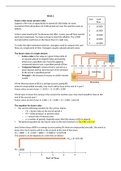Week 2
Year Cash
Future value versus present value
flow
Suppose a firm has an opportunity to spend $15,000 today on some
investment that will produce $17,000 spread out over the next five years as 1 $3,000
follows:
2 $5,000
Is this a wise investment? No because only after 4 years you will have earned 3 $4,000
back your investment. You have to keep in mind the inflation. The 15000
invested will be worth less in the future than it is right now. 4 $3,000
5 $2,000
To make the right investment decision, managers need to compare the cash
flows at a single point of time. Managers usually calculate present value.
The future value of a single amount
• Future value is the value at a given future date of
an amount placed on deposit today and earning
interest at a specified rate. Found by applying
compound interest over a specified period of time.
• Compound interest is interest that is earned on a
given deposit and has become part of the principal
at the end of a specified period.
• Principal is the amount of money on which interest
is paid.
If Fred Moreno places $100 in a savings account paying 8%
interest compounded annually, how much will he have at the end of 1 year?
Future value at end of year 1 = $100 (1 + 0.08) = $108
If Fred were to leave this money in the account for another year, how much would he have at the
end of the second year?
Future value at end of year 2= $100 (1 + 0.08) (1 + 0.08) = $116.64
The equation for future value
• We use the following notation for the various inputs:
– FVn = future value at the end of period n
– PV = initial principal, or present value
– r = annual rate of interest paid.
– n = number of periods (typically years) that the money is left on deposit
• The general equation for the future value at the end of period n is FVn = PV (1 + r)n
Jane Farber places $800 in a savings account paying 6% interest compounded annually. She wants to
know how much money will be in the account at the end of five years.
FV5 = $800 (1 + 0.06)5 = $800 (1.33823) = $1,070.58
This analysis can be depicted on a time line as follows:
, Present value of a single amount
• Present value is the current dollar value of a future amount—the amount of money that
would have to be invested today at a given interest rate over a specified period to equal the
future amount.
• It is based on the idea that a dollar today is worth more than a dollar tomorrow.
• Discounting cash flows is the process of finding present values; the inverse of compounding
interest.
• The discount rate is often also referred to as the opportunity cost, the discount rate, the
required return, or the cost of capital.
Paul Shorter has an opportunity to receive $300 one year from now. If he can earn 6% on his
investments, what is the most he should pay now for this opportunity?
PV (1 + 0.06) = $300
PV = $300/(1 + 0.06) = $283.02
The present value, PV, of some future amount, FVn, to be received n periods from
now, assuming an interest rate (or opportunity cost) of r, is calculated as follows:
PV: FVn : (1 + r)^n
Pam Valenti wishes to find the present value of $1,700 that will be received 8 years from now. Pam’s
opportunity cost is 8%.
1,700
PV = 8 = $918,46
(1,08)
This analysis can be depicted on a time line as follows:
Future value of a stream
Shrell Industries, a cabinet manufacturer, expects to receive the following
mixed stream of cash flows over the next 5 years from one of its small
customers. The required return is 8%. How much do they have after 5 years?
• 11,500 ×1.084 =15,645.62
• 14,000 ×1.083=17,635.97
• 12,900 ×1.082=15,645.62
• 16,000 ×1.081=17,280.00
• 18,000 ×1.080 =18,000.00
If the firm expects to earn at least 8% on its investments, how much will it accumulate by the end of
year 5 if it immediately invests these cash flows when they are received?
This situation is depicted on the following time line.





